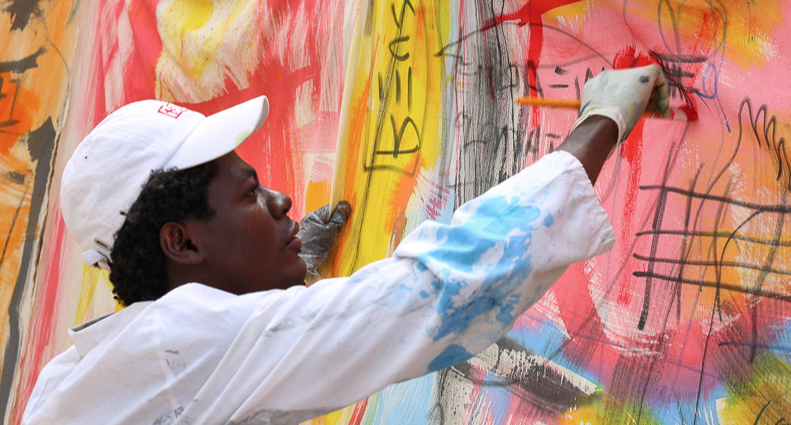The Slum Studio is a social architectural research project. Founded in 2018 by artist Sel Kofiga. The idea behind the company is to remake, resell and repurpose the used textiles that are shipped from the UK, USA, Europe and east Asia.
The Slum studio has found a solution that uses fashion waste to recreate beautiful wearable artwork
These clothes are overwhelming the locals but are a vital part for local market sellers especially in Kantamanto Market. This leaves Ghana in a state of confusion on how to handle the mass load of second hand clothing that are being poured into the country, due to mass production.

Sel Kofiga uses The Slum Studio to send a message to the world. Mainly the power structures that are responsible for the mass production of fashion. Fast Fashion has a big impact on Ghana but also on the environment and the world.
The Slum Studio Uses of Scraps, Clothing and upholstery fabrics
Over the years Ghana have naturally adopted an upcycle culture. The Slum Studio enhance this by painting and re-stitching to give clothing a new lease of life.



“The studio makes hand-painted wearable art from used fabrics while using multifaceted ways to explore the politics of clothing production and consumption” – Sel Kofiga
Sel Kofiga uses fabric scraps and turns them into colourful apparel. Old Curtains are painted and then transformed into clothing. He focuses on taking the political issues that the country faces into artwork.
The Slum Studio inspired by Kantamanto Market
With over 30,000 traders Kantamanto is Ghana’s largest market. The slum studio collects the clothing waste from the market. Whilst visiting the market Sel Kofiga is inspired by how the Market stall owners give secondhand clothing a new lease of life when reselling. Making the buyers feel like they are buying new clothing.
He explains how clothing has travelled from body to body, and how that journey tells a story whilst also being a mystery.

Sel Kofiga collects a story as he walks through the market, by speaking to the store owners and the shoppers. He then reflects his experience into artwork that is translated on to fabric, through illustrations and bright colours.
Kofiga strives to find deeper meaning in the things that he creates. He takes an interest in how the body and clothing co-exist. Clothing is an expression of the wearer.
Final Message from Sel Kofiga on how we can consume more consciously
Using an issue and turning it into colourful fashion artwork. The Slum Studio aims to highlight the current issues that the country face due to fast fashion.
“Yes, we have evolved and become more innovative, but I think it will always depend on our ability to make use of the resources we have.” – Sel Kofiga
Kofiga acknowledges how sustainable fashion has been around for years all over the world, and stresses this is not a new concept! He does, however (Similar to Charlotte H) feel annoyed when bigger brands promote sustainability as a marketing tool.
He believes we should all be more conscience when spending our money. Reminding us that we have the power to choose whether we consume or not, and what we consume.
In an interview with designbloom Kofiga explains
“If you truly care about the clothes, start thinking about what you want to see happen to them next. you have the power to buy, so you have the same power to challenge and question the players involved. you can challenge mass production because it feeds from our purchasing power.” – Sel Kofiga
The future Of The Slum Studio

The Slum Studio also hopes to try out Tapestry and Sculpture developing his mediums whilst still using the unwanted waste.
Kofiga aims to bring the wearer into his journey and make clothes that anyone in the world can wear. He believes in taking pride in our clothing and to treat and treasure it like artwork.

